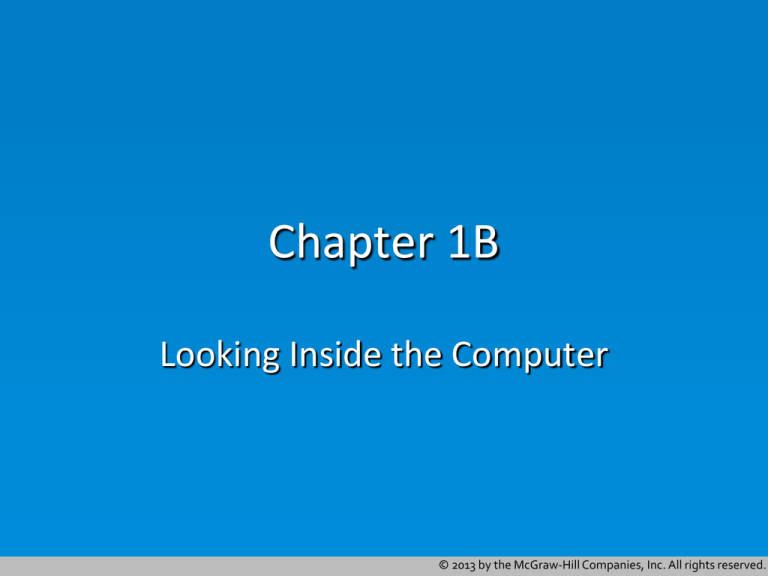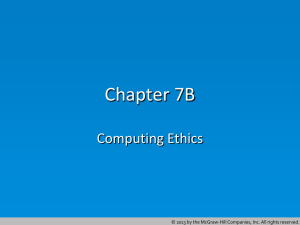
Chapter 1B
Looking Inside the Computer
© 2013 by the McGraw-Hill Companies, Inc. All rights reserved.
2
Learning Objectives
1.4
1.5
1.6
1.7
List the parts of a complete computer system,
and discuss the phases of the informationprocessing cycle.
Identify four basic categories of computer
hardware.
Discuss the role of software as a part of the
computer.
Explain the crucial link between data, users, and
technology.
© 2013 by the McGraw-Hill Companies, Inc. All rights reserved.
3
Computer System
• A computer system is more than a box with
components; it encompasses four elements that
make the machine fully useful:
–
–
–
–
Hardware
Software
Data
Users
© 2013 by the McGraw-Hill Companies, Inc. All rights reserved.
4
The Parts of a Computer
• Hardware consists of the physical (electronic and
mechanical) devices that make up the computer
• Software is a set of instructions that makes the
computer perform tasks
– A program is any piece of software
• Data consist of individual facts or pieces of
information
• Users are the operators of a computer
© 2013 by the McGraw-Hill Companies, Inc. All rights reserved.
5
Information Processing Cycle
• The information processing cycle is a series of steps
the computer follows to receive data:
• Input: The computer accepts data from some source
• Processing: The computer's processing components
perform actions on or with the data
• Output: The computer provides the results of its
processing
• Storage: The computer stores the results of its processing
© 2013 by the McGraw-Hill Companies, Inc. All rights reserved.
6
Essential Computer Hardware
•
•
•
•
Circuit board
Processors
Memory
Input/output devices
– Communication devices
• Storage
© 2013 by the McGraw-Hill Companies, Inc. All rights reserved.
7
Circuit Board
• Circuit board - a piece of
plastic or other material on
which parts are mounted,
organized, and connected
– Circuit boards used to
provide a specific ability are
commonly called cards
– The largest circuit board in a
computer is the
motherboard
© 2013 by the McGraw-Hill Companies, Inc. All rights reserved.
8
Processor
• Processors are the complex electronic circuits that
are responsible for transforming raw data into useful
information (processing the data)
– The main processor for the
computer is the central
processing unit (CPU), which
organizes and carries out
instructions from the user or
software
– In a personal computer, the CPU
consists of a single specialized
chip called a microprocessor
© 2013 by the McGraw-Hill Companies, Inc. All rights reserved.
9
Memory
• Memory is one or more sets of chips that store data
and/or program instructions
– Random access memory (RAM) allows the computer to
store and retrieve data and instructions very quickly
– Read-only memory (ROM) permanently stores data
• ROM is called nonvolatile because the contents are never lost
© 2013 by the McGraw-Hill Companies, Inc. All rights reserved.
10
Input/Output Devices
• Input devices accept data and instructions from the
user or another computer
• Output devices return processed data to the user or
another computer
• Some types of hardware can act as both input and
output devices (e.g., touch screens, communication
devices)
© 2013 by the McGraw-Hill Companies, Inc. All rights reserved.
11
Communication Devices
• Networking is the process of connecting one
computer to another
• Communication devices typically used include:
– Modem: converts digital data to analog signals and analog
to digital
– Network interface cards (NICs): digital-to-digital hardware
components that allow communication and can uniquely
identify the computing device on the network
© 2013 by the McGraw-Hill Companies, Inc. All rights reserved.
12
Storage
• Storage devices hold data permanently. There are
three main types:
– Magnetic disks
– Optical storage
– Solid state drives
• Like memory, storage size is measured in terms of
bytes: the amount of memory it takes to store a
single character, such as a letter or numeral.
• Other storage units: kilobytes, megabytes,
gigabytes, and terabytes.
© 2013 by the McGraw-Hill Companies, Inc. All rights reserved.
13
Magnetic Disks
• Magnetic disks - round,
flat objects that spin
around their center,
almost always housed
inside a case of some
kind
– Read/write heads read
data from the disk or
write data onto the disk
– The complete device
that holds the disk is a
disk drive
© 2013 by the McGraw-Hill Companies, Inc. All rights reserved.
14
Optical Storage
• Optical storage uses lasers to read data from or
write data to the reflective surface of an optical disc
– CD-R disks allow you to create your own disks but cannot
be erased and reused
– CD-RW disks allow you to write and erase data multiple
times on the same disk
– DVDs are popular for permanent, removable storage
because they hold a great deal of data
– Blu-ray discs use a blue-spectrum laser which greatly
increase the disc’s storage capacity
© 2013 by the McGraw-Hill Companies, Inc. All rights reserved.
15
Solid State Drive
• Solid state drive (SSD) - a
memory subsystem that
relies on special kinds of
ROM to permanently store
data
– Flash drives are a type
of SSD that connects to
the computer with a USB
plug
– Also includes the small,
thin memory cards, such
as CompactFlash (CF)
and Secure Digital (SD).
© 2013 by the McGraw-Hill Companies, Inc. All rights reserved.
16
Software
• Software programs tell the computer's hardware
components what to do
• A computer using a program is said to be running or
executing the program
• When software is installed, the program is written
into the computer’s permanent storage
• Application software tells the computer how to
accomplish specific tasks
© 2013 by the McGraw-Hill Companies, Inc. All rights reserved.
17
System Software
• System software is any program that controls the
computer's hardware or can be used to maintain the
computer
– Firmware is used to directly control hardware devices
– Operating systems tell the computer how to use its own
components
– A network operating system allows computers to
communicate and share files
– Utilities are programs that make the computer system
easier to use or perform a highly specialized function
© 2013 by the McGraw-Hill Companies, Inc. All rights reserved.
18
Computer Data
• Data refers to raw materials used to create
information
• Computer data are organized into files, which are
sets of data grouped together and given a name
• A file of data that a user can open and use is often
called a document
© 2013 by the McGraw-Hill Companies, Inc. All rights reserved.
19
The User’s Role
• The following roles are
common for the user of
a personal computer:
–
–
–
–
–
Setting up the system
Installing software
Running programs
Managing files
Maintaining the system
© 2013 by the McGraw-Hill Companies, Inc. All rights reserved.
20
“Userless” Computers
• Many kinds of
computers require no
human interaction
• Typically controlled by
their operating systems
• These systems do have
users, just not users
who directly interact
with the computer
© 2013 by the McGraw-Hill Companies, Inc. All rights reserved.










